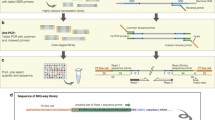Abstract
This study was to explore genomic factors affecting the performance and polymorphism of 340 randomly selected EST-SSR (expressed sequence tag-simple sequence repeat) primers through BLAST of primer sequences to a reference genome. Genotyping showed 111 failed and 229 succeeded. The failed types included “no peaks” (NP, 69 primers), “weak peaks” (WP, 30), and “multiple peaks” (MP, 12). The successful types were divided into HM (homozygous between two selected parents, 78 primers) and HT (heterozygous at least in one parent, 151 primers). The BLAST revealed primer alignment status, genomic amplicon size (GAS), and genomic and expressed amplicon size difference (ASD). The alignment status was categorized as: “no hits found” (NHF); “multiple partial alignments” (MPA); “single partial alignment” (SPA); “multiple full alignments” (MFA); and “single full alignment” (SFA). NHF and partial alignment (PA) mainly resulted from discrepant nucleotides in contig-derived primers. The ASD separated 247 non-NHF primers into: “deletion”, “same size”, “insertion”, “intron (GAS ≤500)”, “intron (GAS >500)”, and “error” categories. Most SFA primers were successful. About 88 % “error”, 53 % NHF primers, and 47 % “intron (GAS >500)” failed. The “deletion” and “insertion” primers had the higher HT rates, and the “same size” had the highest HM rate. Optimized primer selection criteria are discussed.




Similar content being viewed by others
References
Altschul SF, Madden TL, Schaffer AA, Zhang J, Zhang Z, Miller W, Lipman DJ (1997) Gapped BLAST and PSI-BLAST: a new generation of protein database search programs. Nucleic Acids Res 25:3389–3402
Chen C, Gmitter FG Jr (2013) Mining of haplotype-based expressed sequence tag single nucleotide polymorphisms in citrus. BMC Genomics 14:746
Chen C, Zhou P, Choi YA, Huang S, Gmitter FG (2006) Mining and characterizing microsatellites from citrus ESTs. Theor Appl Genet 112:1248–1257
Chen C, Bowman KD, Choi YA, Dang PM, Rao MN, Huang S, Soneji JR, McCollum TG, Gmitter FG (2008) EST-SSR genetic maps for Citrus sinensis and Poncirus trifoliata. Tree Genet Genomes 4:1–10
Doyle JJ, Doyle JL (1987) A rapid DNA isolation procedure for small quantities of fresh leaf tissue. Phytochem Bul 19:11–15
Gmitter FG Jr (2011) The haploid mandarin and diploid sweet orange genome sequences. Plant and Animal Genomes XIX Conference Town and Country Convention Center, San Diego, CA: W146
Gordon D, Abajian C, Green P (1998) Consed: a graphical tool for sequence finishing. Genome Res 8:195–202
Gordon D, Desmarais C, Green P (2001) Automated finishing with autofinish. Genome Res 11:614–625
Kapustin Y, Souvorov A, Tatusova T, Lipman D (2008) Splign: algorithms for computing spliced alignments with identification of paralogs. Biol Direct 3:20
Kong Q, Zhang G, Chen W, Zhang Z, Zou X (2012) Identification and development of polymorphic EST-SSR markers by sequence alignment in pepper, Capsicum annuum (Solanaceae). Am J Bot 99:e59–e61
Miah G, Rafii MY, Ismail MR, Puteh AB, Rahim HA, Islam KhN, Latif MA (2013) A review of microsatellite markers and their applications in rice breeding programs to improve blast disease resistance. Int J Mol Sci 14:22499–22528
Morgante M, Hanafey M, Powell W (2002) Microsatellites are preferentially associated with nonrepetitive DNA in plant genomes. Nat Genet 30:194–200
Narina SS, d’Orgeix CA, Sayre BL (2011) Optimization of PCR conditions to amplify microsatellite loci in the bunchgrass lizard (Sceloporus slevini) genomic DNA. BMC Res Notes 4:26
Navarro E, Espinosa L (2000) Improving quality of expressed sequence tag (EST) databases: recovery of reversed, antisense cDNA sequences. Microb Comp Genomics 5:17–24
Rozen S, Skaletsky H (2000) Primer3 on the WWW for general users and for biologist programmers. Methods Mol Biol (Clifton, NJ) 132:365–386
Saha MC, Mian MA, Eujayl I, Zwonitzer JC, Wang L, May GD (2004) Tall fescue EST-SSR markers with transferability across several grass species. Theor Appl Genet 109:783–791
Saha MC, Cooper JD, Mian MA, Chekhovskiy K, May GD (2006) Tall fescue genomic SSR markers: development and transferability across multiple grass species. Theor Appl Genet 113:1449–1458
Tang J, Vosman B, Voorrips RE, van der Linden CG, Leunissen JA (2006) QualitySNP: a pipeline for detecting single nucleotide polymorphisms and insertions/deletions in EST data from diploid and polyploid species. BMC Bioinformatics 7:438
Thiel T, Michalek W, Varshney RK, Graner A (2003) Exploiting EST databases for the development and characterization of gene-derived SSR-markers in barley (Hordeum vulgare L.). Theor Appl Genet 106:411–422
Varshney RK, Graner A, Sorrells ME (2005) Genic microsatellite markers in plants: features and applications. Trends Biotechnol 23:48–55
Wendel JF, Cronn RC, Alvarez I, Liu B, Small RL, Senchina DS (2002) Intron size and genome size in plants. Mol Biol Evol 19:2346–2352
You FM, Huo N, Gu YQ, Luo MC, Ma Y, Hane D, Lazo GR, Dvorak J, Anderson OD (2008) BatchPrimer3: a high throughput web application for PCR and sequencing primer design. BMC Bioinformatics 9:253
Zhou S, Ji G, Liu X, Li P, Moler J, Karro JE, Liang C (2012) Pattern analysis approach reveals restriction enzyme cutting abnormalities and other cDNA library construction artifacts using raw EST data. BMC Biotechnol 12:16
Acknowledgments
The authors thank Dr. Fred Gmitter for the published genotyping data that was used for categorization of primer performance and genotypes in this study. The research is partially supported by the USDA national program of plant genetic resources, genomics and genetic improvement (Project Number: 6606-21000-004-006).
Author information
Authors and Affiliations
Corresponding author
Additional information
Communicated by S. Hohmann.
This article reports the results of research only. Mention of a trademark or proprietary product is solely for the purpose of providing specific information and does not constitute a guarantee or warranty of the product by the US Department of Agriculture and does not imply its approval to the exclusion of other products that may also be suitable.
Electronic supplementary material
Below is the link to the electronic supplementary material.
Rights and permissions
About this article
Cite this article
Chen, C., Bock, C.H. & Beckman, T.G. Sequence analysis reveals genomic factors affecting EST-SSR primer performance and polymorphism. Mol Genet Genomics 289, 1147–1156 (2014). https://doi.org/10.1007/s00438-014-0875-8
Received:
Accepted:
Published:
Issue Date:
DOI: https://doi.org/10.1007/s00438-014-0875-8




